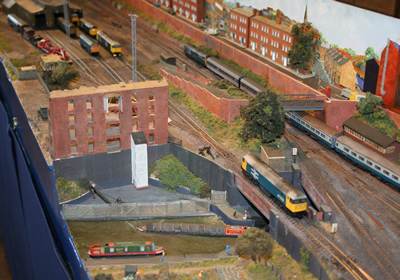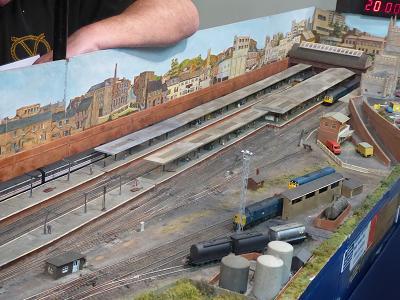Mallingford Central ![]()
Frome Vale Modellers N gauge 2mm scale
Set in the early 1980's the layout represents a terminus station in a fictional large town south of Birmingham, close to the Western Region and London Midland Region boundary and connected to the main line by a triangular junction near the real life station of Kings Norton.
This location was chosen because it seemed to give the maximum amount of interesting and varied passenger train workings together with justification for a small locomotive depot providing servicing facilities for freight locomotives allocated to Bescot and Saltley sheds as well as for passenger locomotives laying over between duties.
A revised version of the Domesday Book shows the hamlet of Mellinge Forde where there was not very much to speak of; however during the Industrial Revolution local resources of clay, coal and iron attracted investment in first the canals then the railways, both the Midland Railway (MR) and the Great Western Railway (GWR) competing for business. The GWR line ran past the outskirts of the town and was closed during the 1960's as part of the Beeching cuts, but before it shut you may have seen it in the factual documentary about the GWR operating practices called The Titfield Thunderbolt.
The Midland/ London Midland Scottish line, which runs into the centre of the town however, continued to prosper, survived the cuts and that is what you see modelled here.
The town is large enough to warrant regular calls by Intercity Cross Country trains together with loco hauled provincial routes and DMU services between Birmingham and Worcester, operating to a sequence based in a British Rail 1982 timetable. Light engines working on and off shed also appear. The star performers are mainly blue diesel, for which the layout owners have a soft spot! These include the now historic class 25's, 40's and 50's.
Visiting shows as both exhibitors and paying punters gives us the impression that this is a much under modelled period of British railway history.
The operating sequence is governed by over 460 cards shared between two operators, each card showing both the train movements and the necessary electrical set up for the train to actually move, hopefully. There are 17 points and 28 switches to provide scope for any lurking gremlins. The whole sequence can take in excess of 6 hours to run through.
The baseboards are built in the standard way using plywood, glues and screwed together.
The station building is scratchbuilt and is a closely detailed representation of Bristol Temple Meads, other buildings are eith scratchbuilt or modified kits from the Kestrel and Peco ranges.
Rolling stock is largely from Graha Farish range and is usually weathered and renumbered, dome of the coaching stock have TPM inlays fitted abd suitably modified roofs and underframes. Other detail items have come from various sources.
We hope you enjoy looking at our model and if you have any questions about it we will endeavour to answer them.



